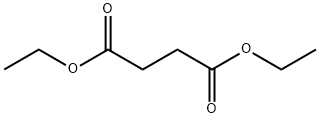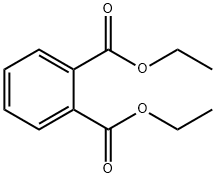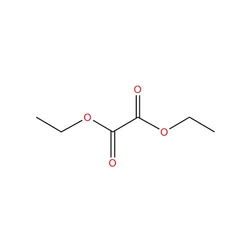Diethyl oxalate
Synonym(s):Diethyl oxalate;Oxalic acid diethyl ester
- CAS NO.:95-92-1
- Empirical Formula: C6H10O4
- Molecular Weight: 146.14
- MDL number: MFCD00009119
- EINECS: 202-464-1
- SAFETY DATA SHEET (SDS)
- Update Date: 2025-12-17 09:49:46

What is Diethyl oxalate?
Chemical properties
colourless liquid
Chemical properties
Anhydrous oxalic acid and ethanol were esterified in the presence of toluene to produce crude diethyl oxalate. The crude ester is distilled into finished product. Raw material consumption quota: 985kg / T oxalic acid, 744kg / T ethanol (95%) and 73.4kg/t toluene. Another preparation method is to add ethanol, benzene and oxalic acid into the reactor, heat it to 68 ℃, azeotrope reflux dehydration, and take no water out as the end point of the reaction, then recover benzene to obtain crude diethyl oxalate, distill under reduced pressure, and collect 103 ℃ / 6kpa fraction to diethyl oxalate. It is purified by washing with dilute sodium carbonate solution, drying anhydrous potassium carbonate or sodium sulfate and vacuum distillation.
Another preparation method is to add 45g (0.5mol) of anhydrous oxalic acid ① (2), 81g (1.76mol) of anhydrous ethanol, 200ml of benzene and 10ml of concentrated sulfuric acid into the reaction bottle equipped with agitator and water separator. It is heated under stirring and refluxed at 68 ~ 70 ℃ for azeotropic dehydration. After the water is basically evaporated, ethanol and benzene are evaporated. Wash with water after cooling, wash with saturated sodium bicarbonate solution, wash with water, and dry with anhydrous sodium sulfate. Diethyl oxalate (57g) was obtained by atmospheric distillation and collecting the fraction at 182 ~ 184 ℃, with a yield of 78%. ① dehydrate oxalic acid with anhydrous chloroform water until it crystallizes as follows: steam it with anhydrous oxalic acid and inject it into the powder containing carbon. Filter by suction, dry and store in dryer for standby. Anhydrous oxalic acid can also be prepared by drying directly in an oven. In this experiment, a corresponding amount of oxalic acid containing crystal water can also be used, but the reaction time is longer.
The Uses of Diethyl oxalate
Diethyl oxalate is used to prepare active pharmaceutical ingredients (API), plastics and dyestuff intermediates. It is also used as a solvent for cellulose esters, ethers, resins, perfumes and lacquers for electronics. It is involved in the transesterification reaction with phenol to get dipheny oxalate. It is also involved in the Claisen condensation ketosteroids to prepare glyoxalyl derivatives. Further, it is used to prepare sym-1,4-diphenyl-1,4-dihydro-1,2,4,5-polytetrazine. In addition to this, it is utilized in the microemulsion synthesis of zinc oxide nanoparticles.
The Uses of Diethyl oxalate
manufacture of phenobarbital, ethylbenzyl malonate, triethylamine, and similar chemicals, plastics, dyestuff intermediates. Solvent for cellulose esters, perfumes.
Production Methods
Diethyl oxalate is produced via esterification of ethanol and oxalic acid. It is a preferred solvent for cellulose acetate and nitrate.
What are the applications of Application
Diethyl oxalate has the general properties of esters. It absorbs moisture in the air and decomposes slowly. It reacts with ammonia to form amide compounds and condenses with acetone to ethyl pyruvate. It is mainly used in the pharmaceutical industry. It is an intermediate of azathioprine, peripheral sulfanilamide, carboxyphenyllipase penicillin, ethoxybenzylpenicillin, chloroquine lactate, thiabendazole, sulfamethoxazole and other drugs. It can be used as an intermediate of plastics, dyes and other products, and as a solvent of cellulose and spices.
Diethyl acetate is often used as the substrate of nucleophilic reagent α,γ- Dicarbonyl esters, ketone compounds, synthesis of heterocyclic compounds, etc. synthesis α,γ- Dicarbonyl esters can be formed by nucleophilic substitution reaction between ketones and diethyl oxalate under alkaline conditions α,γ- Dicarbonyl ester (formula 1). The dicarbonyl ester often exists in enol structure and can be used to synthesize heterocyclic compounds (formula 2)
General Description
A colorless liquid. Flash point 168°F. Slightly denser than water and insoluble in water. Hence sinks in water. May irritate skin and mucous membranes; may be mildly toxic by ingestion; may emit irritating fumes in a fire. Vapors are much heavier than air. Used as a solvent for plastics and in the manufacture of perfumes and pharmaceuticals.
Air & Water Reactions
Insoluble in water.
Reactivity Profile
Diethyl oxalate is an ester. Esters react with acids to liberate heat along with alcohols and acids. Strong oxidizing acids may cause a vigorous reaction that is sufficiently exothermic to ignite the reaction products. Heat is also generated by the interaction of esters with caustic solutions. Flammable hydrogen is generated by mixing esters with alkali metals and hydrides
Hazard
Toxic by ingestion, strong irritant to skin and mucous membranes.
Health Hazard
TOXIC; inhalation, ingestion or contact (skin, eyes) with vapors, dusts or substance may cause severe injury, burns or death. Contact with molten substance may cause severe burns to skin and eyes. Reaction with water or moist air will release toxic, corrosive or flammable gases. Reaction with water may generate much heat that will increase the concentration of fumes in the air. Fire will produce irritating, corrosive and/or toxic gases. Runoff from fire control or dilution water may be corrosive and/or toxic and cause pollution.
Fire Hazard
Combustible material: may burn but does not ignite readily. Substance will react with water (some violently) releasing flammable, toxic or corrosive gases and runoff. When heated, vapors may form explosive mixtures with air: indoors, outdoors and sewers explosion hazards. Most vapors are heavier than air. They will spread along ground and collect in low or confined areas (sewers, basements, tanks). Vapors may travel to source of ignition and flash back. Contact with metals may evolve flammable hydrogen gas. Containers may explode when heated or if contaminated with water.
Safety Profile
Poison by ingestion. Flammable liquid when exposed to heat or flame; can react with oxidzing materials. To fight fire, use foam, CO2, dry chemical. When heated to decomposition it emits acrid smoke and fumes. See also OXALATES and ESTERS.
Properties of Diethyl oxalate
| Melting point: | -41 °C (lit.) |
| Boiling point: | 185 °C (lit.) |
| Density | 1.076 g/mL at 25 °C (lit.) |
| vapor density | 5.03 (vs air) |
| vapor pressure | 1 mm Hg ( 47 °C) |
| refractive index | n |
| Flash point: | 168 °F |
| storage temp. | Store below +30°C. |
| solubility | Miscible with alcohols, ether and other common organic solvents. |
| form | Liquid |
| color | Clear |
| explosive limit | 0.42-2.67%(V) |
| Water Solubility | MAY DECOMPOSE |
| Sensitive | Moisture Sensitive |
| Merck | 14,3125 |
| BRN | 606350 |
| Dielectric constant | 8.2(21℃) |
| Stability: | Stable, but moisture sensitive. Incompatible with strong oxidizing agents. |
| CAS DataBase Reference | 95-92-1(CAS DataBase Reference) |
| NIST Chemistry Reference | Ethanedioic acid, diethyl ester(95-92-1) |
| EPA Substance Registry System | Ethyl oxalate (95-92-1) |
Safety information for Diethyl oxalate
| Signal word | Danger |
| Pictogram(s) |
 Corrosion Corrosives GHS05  Exclamation Mark Irritant GHS07  Health Hazard GHS08 |
| GHS Hazard Statements |
H302:Acute toxicity,oral H314:Skin corrosion/irritation H373:Specific target organ toxicity, repeated exposure |
| Precautionary Statement Codes |
P260:Do not breathe dust/fume/gas/mist/vapours/spray. P280:Wear protective gloves/protective clothing/eye protection/face protection. P314:Get medical advice/attention if you feel unwell. P301+P312:IF SWALLOWED: call a POISON CENTER or doctor/physician IF you feel unwell. P303+P361+P353:IF ON SKIN (or hair): Remove/Take off Immediately all contaminated clothing. Rinse SKIN with water/shower. P305+P351+P338:IF IN EYES: Rinse cautiously with water for several minutes. Remove contact lenses, if present and easy to do. Continuerinsing. |
Computed Descriptors for Diethyl oxalate
| InChIKey | WYACBZDAHNBPPB-UHFFFAOYSA-N |
Diethyl oxalate manufacturer
New Products
Indole Methyl Resin tert-butyl 9-methoxy-3-azaspiro[5.5]undecane-3-carboxylate Boc-His(Boc)-OH 2-CTC Resin 4-Chloro-7-tosy1-7Hpyrrolo[2,3-d]pyrimidine 5,7-Dibromo-1H-indole 2,5-dichloro-N-hydroxy-4,6-dimethylpyridine-3-carboximidamide 2,2-Dimethoxy-7-azaspiro[3.5]nonane hydrochloride 4-chloromethyl-5-methyl-1,3-dioxol-2-one (DMDO-Cl) R-2-BENZYLOXY PROPIONIC ACID 1,1’-CARBONYLDIIMIDAZOLE 1,1’-CARBONYLDI (1,2-4 TRIAZOLE) N-METHYL INDAZOLE-3-CARBOXYLIC ACID 4-((2-hydroxyethyl)thio)benzoic acid 1-(TERT-BUTOXYCARBONYL)-2-PYRROLIDINONE Methyl 6-methylnicotinate 3-Pyridineacrylic acid tert-Butyl carbazate TETRAHYDRO-2H-PYRAN-3-OL 2-((4-morpholinophenylamino) (methylthio) methylene) malononitrile 3-(4-morpholinophenylamino)-5-amino-1H-pyrazole-4-carbonitrile 2,4-dihydroxybenzaldehyde 1,3-Diethyl-1,3-Diphenylurea Methyl 2-methylquinoline-6-carboxylateRelated products of tetrahydrofuran








You may like
-
 Diethyl Oxalate 99%View Details
Diethyl Oxalate 99%View Details -
 Diethyl oxalate CAS 95-92-1View Details
Diethyl oxalate CAS 95-92-1View Details
95-92-1 -
 Diethyl oxalate 99% (GC) CAS 95-92-1View Details
Diethyl oxalate 99% (GC) CAS 95-92-1View Details
95-92-1 -
 Diethyl Oxalate pure CAS 95-92-1View Details
Diethyl Oxalate pure CAS 95-92-1View Details
95-92-1 -
 Diethyl Oxalate, 99.75%View Details
Diethyl Oxalate, 99.75%View Details
95-92-1 -
 Diethyl OxalateView Details
Diethyl OxalateView Details
95-92-1 -
 200 g Diethyl Oxalate, For IndustrialView Details
200 g Diethyl Oxalate, For IndustrialView Details
95-92-1 -
 Diethyl OxalateView Details
Diethyl OxalateView Details
95-92-1
